A journey 400,000 years back in human history
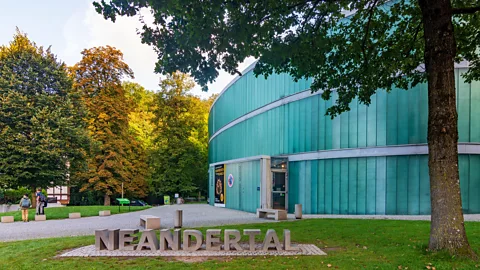 Alamy
AlamyNestled in Germany's picturesque Neander Valley where Neanderthals were first discovered, a museum is tapping into our growing fascination with our long-lost relatives.
Inside a museum in western Germany, a man in a tailored suit and a dress shirt leaned against a handrail and peered down towards the gallery below. A young girl briefly paused next to him as a few visitors stopped to stare. Something about the scene seemed subtly out of sorts.
The elegantly dressed gentleman had a noticeable ridge on his brow, his nose was large and his chin was recessed.
"We call him Mr Four Percent," said the museum's director, Bärbel Auffermann. Because he was clad in modern clothes, it was easy to overlook the life-like statue's secret: he's a Neanderthal.
The statue conveys an important point – this ancient cave-dwelling hominid is really not much different than us. Indeed, genetic research shows that many humans have up to 4% Neanderthal DNA. In fact, while scientists once believed that Neanderthals, who disappear from the fossil record around 40,000 years ago, were violently displaced by their more slender hominid cousins (us), they now believe humans and Neanderthals interbred for thousands of years until the Neanderthal population eventually disappeared.
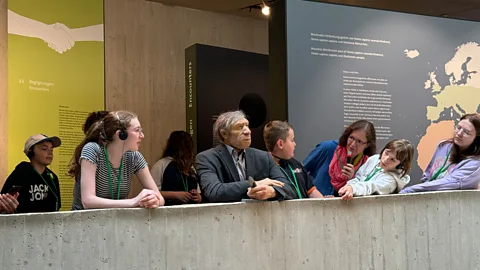 Larry Bleiberg
Larry BleibergLocated 15km east of Dusseldorf, the Neanderthal Museum lies just a short walk from the spot where the species was first identified in Germany's Neander Valley in the 1850s. Using startlingly realistic models, Ice Age artefacts and easy-to-follow exhibits, the museum takes visitors on a four-million-year journey to discover humankind's distant origins. A visit isn't just an homage to paleoanthropology, it's more like a trip to see our long-lost cousins.
Since the pandemic, interest in the museum has surged. In 2023, 180,000 Neanderthal fans flocked to the museum – its highest number since the initial rush of visitors following its opening in 1996 – and according to Auffermann, the museum is on pace to hit that number again this year. Meanwhile, an accelerating stream of scientific discoveries and the increasing popularity of at-home DNA testing continues to spark curiosity in our fellow sapiens.
But despite our close relations, Neanderthals have a serious PR problem. Auffermann said most people consider this extinct group of ancient humans were little more than ignorant cavemen – grunting brutes with a club. "From the very beginning we understood it as our mission to rectify this image. We always understood ourselves as being their lawyers, their representatives," she said.
In the last two years, the museum has opened a Stone Age-themed playground with a crawl-through cave and giant spear-shaped timbers supporting a slide and swings. It has also unveiled a soaring 22m "cave view" observation tower and exhibit, topped with a massive Neanderthal skull, which was nominated for a European Museum of the Year award in 2024.
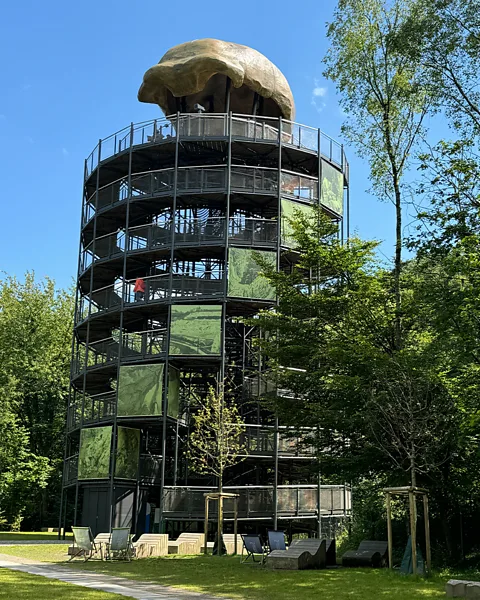 Larry Bleiberg
Larry BleibergAll this comes as perceptions about neanderthals are shifting. Some 400,000 years after they first appeared and 40,000 years after they went extinct, a surge of new documentaries, books and studies about the species have been published in the past 12 months.
In addition to its other new offerings, on 23 November, the museum will open a temporary exhibit focusing on the role women played in Neanderthal society. Author Rebecca Wragg Sykes, whose 2020 international best-selling book Kindred: Neanderthal Life, Love, Death and Art narrates the accompanying audio tour. Drawing on research, Sykes takes visitors through the lives of four ancient women as they give birth, raise children, hunt and care for their families.
Sykes, who also leads a 10-day holiday tour to Neanderthal sites across Europe, traces our current fascination with the species to the 2010 sequencing of the Neanderthal genome, which revealed that the DNA of Neanderthals and modern humans are 99.7% identical.
"It changed the Neanderthal from something that once existed and vanished to something that's still present now," she told the BBC. "People found it an emotional thing. They said: 'I feel connected to part of my past in a way that's unexpected and really moving.'"
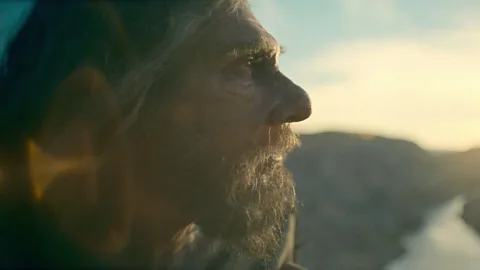 Alamy
AlamyResearch has continued to broaden our understanding of the species. We now know they were quite sophisticated, making rope, painting caves and caring for the injured and disabled, including – as one recent finding suggests – a child with Down syndrome.
"Neanderthals are individuals. They [were] hunting the same things [as us]… they have hearths at the centre of their social life, just like us," Sykes said.
Humans' first glimpse of our distant ancestors took place just 400m from the museum, which is located in the woods where the Düssel River once flowed through a towering limestone canyon. Even now, this quiet, pastoral pocket of industrial western Germany seems an unlikely site to have changed our understanding of human evolution.
Like England's Lake District and New York's Hudson Valley, the Neander Valley attracted Romantic painters during the early 1800s who were drawn by its untamed, picturesque landscape. After sketching the scenery, they'd retreat to caves and rock shelters for picnics and parties. As the Industrial Revolution intensified in the mid-1800s, limestone became a valuable commodity for iron makers, and stoneworkers were brought in from Italy to quarry the cliffs.
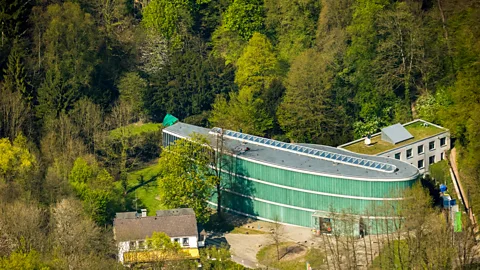 Larry Bleiberg
Larry BleibergIn August 1856, labourers began digging out the clay floor of a cave and discovered16 fossilised bones from a single individual. A local teacher and naturalist named Johann Carl Fuhlrott was called in, and immediately sensed the find was noteworthy. The remains suggested a stocky, powerful body, unlike a typical human. Fuhlrott and a colleague named the species after the valley where it was found: Homo neanderthalensis.
While Neanderthals are certainly the prime attraction, the museum takes visitors on a journey through the greatest hits of human evolution. Life-size figures are arranged in a timeline, including Lucy (Australopithecus afarensis), our ape-like ancestor who lived 3.2 million years ago and is often considered "The Mother of Man". She poses alongside Homo erectus (our relative from 1.6 million years ago) and Homo sapiens, our modern species who first appeared 300,000 years ago.
But the star is "Mr N", a life-like statue of an impish, naked Neanderthal. With a thick beard ringing his jaw and stylish long hair, he reminded me of a prehistoric hipster. As I approached the exhibit, I was blocked by a small crowd of visitors gathering to take photos of the figure, who seemed to gaze back with a sly grin.
Today, Mr N serves as the museum's de facto mascot, and has been so popular that he had to be replaced after his predecessor's skin was worn down when too many visitors couldn't resist the chance to touch the past.
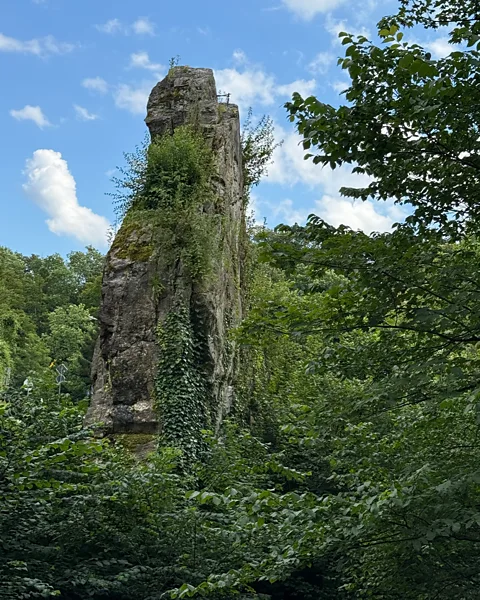 Larry Bleiberg
Larry Bleiberg"He's some sort of identification figure," said Auffermann. "People of the region, they like him a lot."
Outside the museum, the steep gorges that once lured painters have been removed, quarry shovel by quarry shovel. Only one towering plinth remains, where a large metal tablet with gothic lettering commemorates the original Neanderthal discovery. Nearby, a path leads past the rock to the new observation tower at the edge of a forest.
More like this:
• How did the last Neanderthals live?
The wheelchair-accessible structure carries visitors up a circular walkway, interrupted by interpretive panels with recorded narration. The climb culminates at a viewing platform, where telescopes reveal a virtual-reality landscape populated with mammoths, woolly rhinoceroses and Neanderthals. The tower's peak stands at roughly the same spot and elevation as the cave floor where we first came face to face with our distant relatives.
"It's a bit like visiting the grave of your ancestor," Skyes said. "It's kind of crazy – this giant tower with a skull at top. It's a way to allow people to be as close as possible to the space where that actual cave was. I think it's rather wonderful."
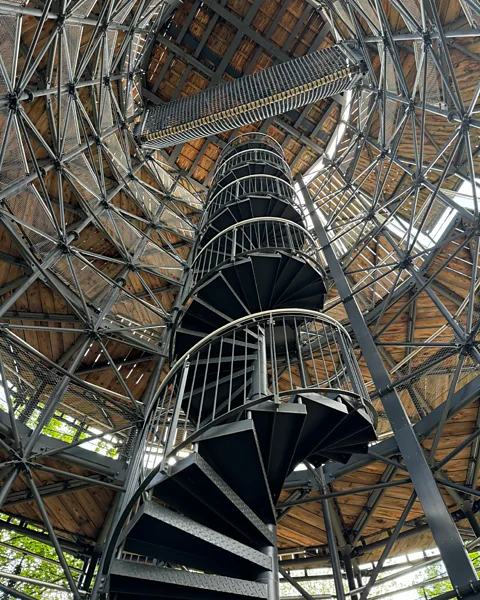 Larry Bleiberg
Larry BleibergAs each new finding deepens our understanding of our world – and ourselves – Skyes said she expects interest in Neanderthals to continue to grow.
"Neanderthals are interesting for their own sake, not because of their relevance to us," she said. "Even if we had never interbred with them, it's still interesting as another experiment of what it is to be a human."
--
If you liked this story, sign up for The Essential List newsletter – a handpicked selection of features, videos and can't-miss news, delivered to your inbox twice a week.
